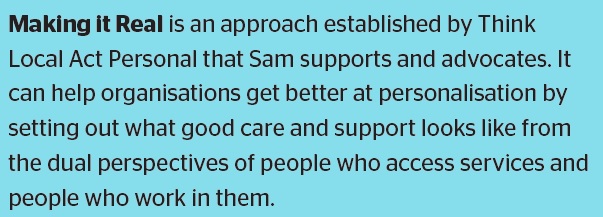How to do personalised care and support - for home living
There's young man living in the community. He has ambition and humour. He also has autism and epilepsy. Sam can say with confidence: ‘I have a place I can call home and I can live the life I want’. It’s an enviable position. How many of us can say this with as much certainty? The young man's name is Sam Ward and this is his story.
Supported living arrangement
Sam lived for years in supported living where despite many set-backs he never gave up on his desire for a life of his choosing and always questioned the lack of choice that the traditional service had to offer him.
For years, Sam had been trying to live the life he wanted but kept coming up against barriers. In his supported living accommodation, he’d expected respect and decency but received little. Locked out at night - more than once, his post went missing, he had no control over his laundry, nor his electricity and water meters. But the two things he really hated was that he had to be away from home between 10am and 2pm, or be reprimanded, or worse he had to inform the manager 24hrs before he had visitors, so family and friends weren’t allowed to just “pop” in.
Sam tried hard to change things- offering constructive ideas, talking about co-production and asking the staff to work with him and the other people whose home he shared. As things worsened, the mood changed for everyone who lived there.
Using a direct payment
Luckily, Sam was helped by good friends to find a new home to rent. It wasn’t easy. Many private landlords won’t rent to people in receipt of housing benefits, but he managed to find an understanding landlord. Since he also receives a direct payment he chose to spend the money on employing his own personal assistants. This situation means that his support is separate from his accommodation, finally he has the choice and control he so craved. Today Sam has two personal assistants, and an advocate and payroll provider to support him with his employment responsibilities.
Sam is passionate about nature and the environment. He enjoys watching birds and local wildlife and is keen on recycling. One of the first things he did when he moved to his new home was to buy a second-hand lawnmower. He loved the look and smell of the freshly mowed lawn and was so proud and happy that he could do it for himself. He looks after his household bills and is learning how to manage his weekly budget. He can do his washing when he wants. He can go for a walk round the block and he’s getting to know his neighbours.
Throughout the discrimination and sadness of not having the right support, Sam remained strong. He knew that what he needed was to be included in the conversations about his care and support. People, relationships, sharing power – these are the components that humanised his experiences of getting help, not his exposure to workforce concerns like contracts, targets, and budgetary cycles. It’s been an emotional time, but his tears were tears of joy when he moved into his own perfect home.
Sam's message to providers
Sam’s message to providers is that they should make the time to engage in genuine conversations with people in their care. If they can express I statements from Making it Real to describe their experiences, then that’s personalisation!
Making it Real is an approach that Sam supports and advocates. It can help organisations get better at personalisation by setting out what good care and support looks like from the dual perspectives of people who access services and people who work in them.
Sam was interviewed by his colleague Caroline Waugh from the National Coproduction Advisory Group, part of Think Local Act Personal (TLAP).
The original version of this article first appeared in Care Talk magazine February edition.


Comments
Add your comment